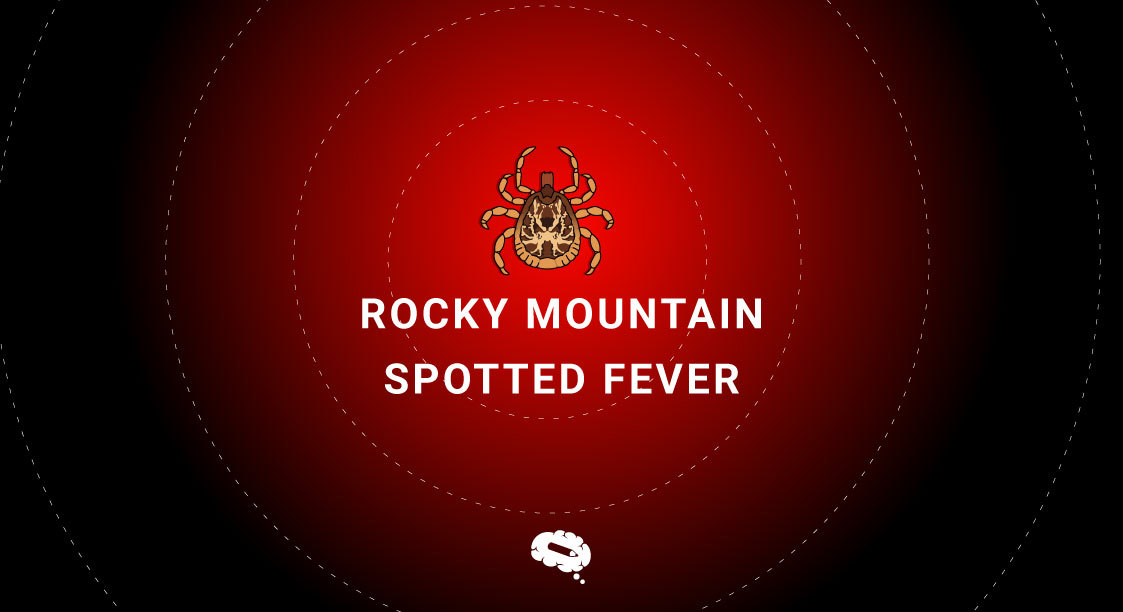Rocky Mountain spotted fever (RMSF) is a tick-borne infectious disease caused by the bacterium Rickettsia rickettsii. It is a potentially serious condition that requires prompt medical attention. In this article, we will delve into the various aspects of Rocky Mountain spotted fever, including its symptoms, diagnosis, treatment, prevention, and potential complications.
What is Rocky Mountain spotted fever? How does it affect the body?
Rocky Mountain Spotted Fever is a tick-borne illness caused by the bacterium Rickettsia rickettsii. The American dog tick primarily transmits it, but other ticks can also transmit the disease. RMSF can affect a variety of organ systems in the body, including the skin, blood vessels, and the nervous system.
How common is Rocky Mountain spotted fever?
Rocky Mountain Spotted Fever is relatively rare, with estimated 1,000-10,000 cases reported annually in the United States. The disease is primarily found in the western and southern regions of the country, where the American dog tick, the primary vector for RMSF, is common.
However, it is important to note that RMSF is likely under-reported, as the early symptoms of the disease can be easily mistaken for other illnesses, such as the flu. In addition, not all individuals bitten by an infected tick will develop the disease, as the majority of tick bites do not result in illness.
What time of year is RMSF most commonly reported?
Rocky Mountain Spotted Fever is a seasonal disease and is most commonly reported during the spring and summer months. The American dog tick, the primary vector for RMSF, is most active from March to October, with the highest levels of tick activity occurring in the months of May and June.
During this time, individuals may be more likely to encounter ticks in areas where the risk of RMSF is high, such as wooded and grassy areas in the western and southern regions of the United States. It is important for individuals to take precautions to prevent tick bites, such as wearing protective clothing and checking for ticks after outdoor activities.
What tests diagnose Rocky Mountain spotted fever?
To diagnose Rocky Mountain Spotted Fever, a doctor will typically undertake a combination of tests, including:
- Physical exam: The doctor will perform a physical examination to assess the patient’s general health and any signs and symptoms of RMSF.
- Blood tests: The doctor may order blood tests to look for signs of RMSF, such as elevated levels of liver enzymes, a low white blood cell count, or elevated levels of proteins in the blood.
- Antibody tests: Blood tests can also be used to look for antibodies to the Rickettsia rickettsii bacteria, which can indicate a previous or current infection.
- Polymerase chain reaction (PCR) tests: PCR tests can be used to detect the presence of the Rickettsia rickettsii bacteria in blood or other body fluids.
- Skin biopsy: In some cases, a skin biopsy may be performed to look for signs of RMSF, such as hemorrhagic lesions.
It is important to note that a diagnosis of RMSF is often clinical, based on the combination of signs and symptoms, the patient’s exposure history, and the results of diagnostic tests. Symptoms of RMSF can overlap with those of other illnesses, so a combination of tests may be needed to make a diagnosis. In addition, early diagnosis and treatment are important to prevent serious complications.
How can I reduce my risk of Rocky Mountain spotted fever?
To reduce your risk of Rocky Mountain Spotted Fever, you can take the following steps:
- Wear protective clothing: Wear long sleeves, pants, and boots tucked into socks to prevent tick bites. You may also want to wear light-colored clothing to make it easier to spot any crawling ticks.
- Check for ticks: After spending time outdoors, immediately check yourself and any pets for ticks. Look for ticks in areas where the risk of RMSF is high, such as wooded and grassy areas.
- Use insect repellent: Use insect repellent that contains DEET, picaridin, or IR3535 on exposed skin to help prevent tick bites.
- Remove ticks promptly: Remove any ticks promptly by using fine-tipped tweezers to grasp the tick as close to the skin as possible and then gently pull up and away from the skin. Do not puncture, crush, or twist the tick’s body, as this can increase the risk of infection.
- Monitor for symptoms: Monitor yourself and any pets for the symptoms of RMSF, including a high fever, rash, nausea, vomiting, aches, and chills. Seek medical attention promptly if you suspect you or your pet may have RMSF.
How to treat Rocky Mountain spotted fever?
If the diagnosis is positive, antibiotics should be started immediately. This is because the disease can progress quickly and be fatal in rare cases, so early treatment is critical.
The choice of antibiotic depends on the severity of the disease. For milder cases, doxycycline can be used for 3-7 days, while for more severe cases, treatment with a combination of doxycycline and ceftriaxone may be recommended. Treatment should continue for 2-3 weeks, even if the patient appears to have fully recovered, to reduce the risk of relapse.
What is the fatality rate of RMSF?
The fatality rate of Rocky Mountain Spotted Fever can vary depending on factors such as the patient’s age, underlying health, and the timeliness of treatment. According to the CDC, the overall case fatality rate for RMSF is typically <1%, but in severe cases or without treatment, the fatality rate can be as high as 20-30%.
In the United States, the fatality rate of RMSF is relatively low, if compared to other parts of the world where the disease is endemic. In the United States, the disease can often be diagnosed and treated early, which helps to prevent severe complications and promote a full recovery.
How does Rocky Mountain spotted fever spread? Can it spread from person to person?
Rocky Mountain Spotted Fever is primarily transmitted through the bite of infected ticks, such as the American dog tick, the Rocky Mountain wood tick, and the Western black-legged tick. The American dog tick is the primary vector for the disease in the United States, while the Rocky Mountain wood tick is the primary vector in other parts of the world.
Person-to-person transmission of RMSF is extremely rare and typically occurs through exposure to the blood or body fluids of an infected individual, such as through transfusion or organ transplant. RMSF cannot be transmitted through casual contact or exposure to an infected individual’s respiratory droplets.
What are the complications of Rocky Mountain spotted fever?
Rocky Mountain Spotted Fever can cause serious complications if left untreated. Potential complications of RMSF include:
- Brain and nerve damage: RMSF can cause brain damage, including different cases of brain inflammation, such as meningoencephalitis and encephalitis. This can result in confusion, seizures, and neurological symptoms.
- Kidney damage: RMSF can cause kidney damage, leading to kidney failure and requiring dialysis.
- Respiratory distress: RMSF can cause respiratory distress and pneumonia, which can be life-threatening.
- Shock and systemic toxicity: RMSF can cause shock and systemic toxicity, leading to multiple organ failure and, in rare cases, death.
In extreme cases, RMSF can be fatal, especially if the disease goes undiagnosed or is untreated. Early diagnosis and antibiotic treatment can prevent most complications and promote a full recovery.
Is Rocky Mountain spotted fever the same as Lyme disease?
No. Rocky Mountain Spotted Fever and Lyme disease are different diseases caused by different organisms. RMSF is caused by infection with the bacterium Rickettsia rickettsii, which is transmitted to humans through the bite of certain infected ticks. Lyme disease is caused by infection with the bacterium Borrelia burgdorferi and is transmitted to humans through the bite of infected ticks, primarily the black-legged tick.
While RMSF and Lyme disease have similar symptoms, they are distinct diseases with different clinical presentations, laboratory findings, and treatments. RMSF usually presents with a sudden high fever, headache, muscle aches, and a rash, while Lyme disease can present with a variety of symptoms, including fever, rash, and joint pain. RMSF can progress quickly if untreated, while Lyme disease may be more insidious and present months after exposure to an infected tick.
When should I see my healthcare provider about Rocky Mountain spotted fever?
If you suspect you may have Rocky Mountain Spotted Fever, you should see your healthcare provider as soon as possible. RMSF can progress quickly and cause serious complications if left untreated, so immediate antibiotic treatment can be critical to promote a full recovery.
Symptoms of RMSF usually begin to develop 3-14 days after a tick bite. Typical symptoms include a sudden high fever, headache, joint aches and stiffness, and a rash that appears in phases. If any of these symptoms develop within two weeks of a tick bite, you should seek medical attention promptly.
If you are aware of a tick bite, especially if you have recently been hiking or camping in areas where ticks are common, you should monitor yourself for symptoms of RMSF and seek medical attention promptly if symptoms develop.
Does Rocky Mountain spotted fever ever go away?
Rocky Mountain Spotted Fever can be treated with antibiotics and is usually a self-limiting disease, meaning it will resolve on its own without treatment. However, in rare cases, untreated RMSF can lead to serious complications, including brain damage, kidney damage, and even death.
With prompt diagnosis and appropriate treatment, RMSF is typically easily treated and cured. The vast majority of individuals who receive appropriate antibiotic treatment will make a full recovery, although some may have lingering symptoms or delayed complications.
Boost Your Content with Eye-Catching Infographics
Discover the power of infographics and how Mind the Graph can help you create captivating visuals. Enhance your content, engage your audience, and convey complex information effectively with stunning infographics.
Let us imagine how Infographics could illustrate this article’s content:
- Visualizing the Spread: An infographic could depict the lifecycle of the tick that transmits the disease, highlighting the stages and areas where it is common to find it. Visual representations can help readers understand the spread of the disease and the importance of prevention measures.
- Symptoms and Diagnosis: An infographic can display the common symptoms of Rocky Mountain spotted fever, such as fever, rash, and neurological symptoms, along with the diagnostic process. It can visually explain the various tests involved in diagnosing the disease, making it easier for readers to grasp the information.
- Prevention Tips: Creating an infographic that highlights preventive measures can be highly effective. It can include visuals of individuals wearing protective clothing, using insect repellent, and checking for ticks. This visual guide can help readers understand and remember the necessary steps to reduce their risk of contracting the disease.
- Treatment Options: An infographic can outline the different antibiotic treatment options for Rocky Mountain spotted fever based on the severity of the disease. It can provide a clear comparison of the medications and their recommended duration, aiding readers in understanding the treatment process.
- Complications and Fatality Rates: Using an infographic to display the potential complications of the disease, such as brain and nerve damage, kidney damage, respiratory distress, and systemic toxicity, can visually communicate the severity and urgency of seeking timely treatment. Additionally, it can highlight the fatality rates associated with Rocky Mountain spotted fever to emphasize the importance of early intervention.
- Differentiating RMSF from Lyme Disease: An infographic can compare and contrast Rocky Mountain spotted fever with Lyme disease, illustrating the key differences in terms of causative organisms, vectors, symptoms, and geographic prevalence. This visual representation can help readers differentiate between the two diseases more easily.
By incorporating these infographics throughout the blog post, readers can quickly grasp important information, improve their understanding of the topic, and retain the knowledge more effectively. Infographics engage visual learners and make complex information more digestible, enhancing the overall user experience.

Subscribe to our newsletter
Exclusive high quality content about effective visual
communication in science.





